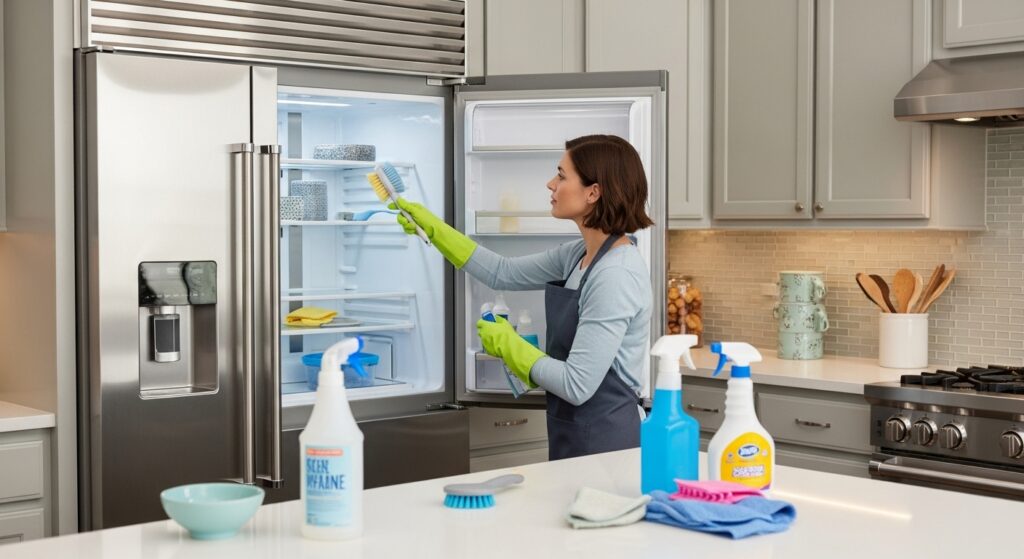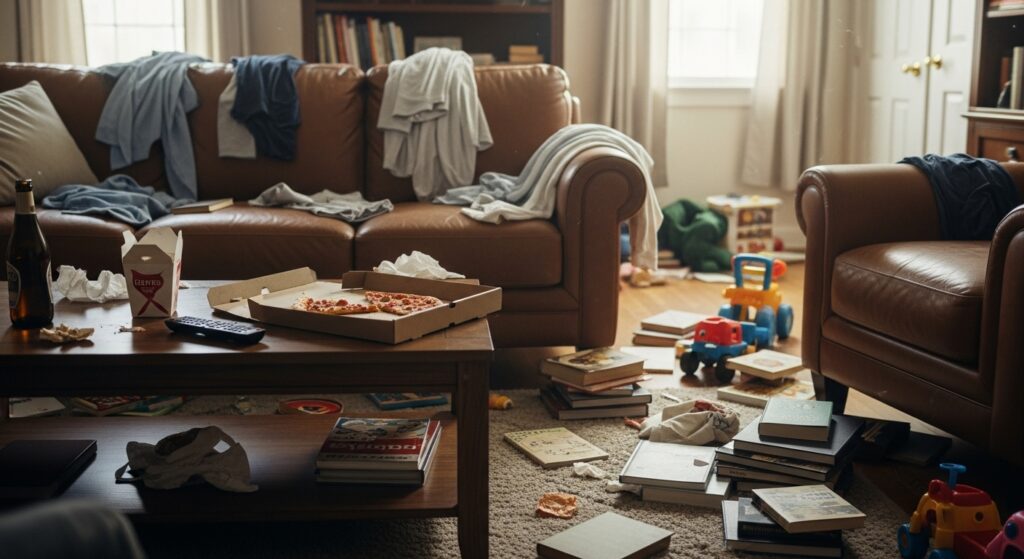Tips for Cleaning a Messy House
Cleaning a messy house can feel completely overwhelming, especially when clutter has piled up and chores seem endless. It’s easy to get stuck, not knowing where to start or how to make progress without feeling defeated. The key is to break the task into manageable steps that feel doable instead of daunting.
By dividing the cleaning into smaller parts and tackling them one at a time, you’ll regain control over your space and your stress levels. This guide offers practical, step-by-step tips designed to help you move forward with confidence and get your home back to a place where you feel calm and comfortable.
Start Small and Build Momentum
When faced with a messy house, it’s tempting to want to clean everything all at once. But this approach often leads to burnout and frustration. Instead, start small by focusing on one area or task at a time, such as a single room, closet, or even just a countertop.
Starting small not only makes the work feel more manageable but also builds momentum. Each small success motivates you to keep going, turning what feels like an overwhelming mountain into achievable steps. From personal experience, this simple habit of breaking down the mess into bite-sized pieces has been a game changer in keeping my home clean and organized.
Prepare Before You Start
Before diving into cleaning, it’s important to get everything ready. Gather all the cleaning supplies and tools you’ll need, such as cleaners, cloths, vacuum, mop, trash bags, and gloves. Having everything on hand will help you work efficiently without interruptions.
Creating or printing a cleaning checklist or planner can keep you organized and focused. This way, you can tick off tasks as you go and stay motivated. Also, set a realistic timeline or schedule for your cleaning session, so you know what you can achieve without feeling overwhelmed. Planning ahead like this sets you up for success.

Start Small and Focused
When faced with a messy house, it’s easy to feel overwhelmed by the sheer amount of cleaning needed. The best way to tackle this is to start small by choosing one room or even just one area to focus on. This approach makes the task feel more manageable and gives you a quick win to build momentum.
Focus on completing that small section fully before moving on. Whether it’s a cluttered countertop or a messy closet, finishing one spot at a time helps you avoid burnout and keeps your motivation high. Remember, progress is progress, no matter how small!
Sort and Declutter Everything
Before diving into cleaning, take the time to go through everything in the area you’re tackling. Remove items that don’t belong, and sort your belongings into piles: keep, donate, or throw away. This step is essential because clutter often makes cleaning harder and less effective.
Decluttering not only frees up space but also gives you a clearer path to clean surfaces thoroughly. Plus, donating items you no longer need is a great way to help others and reduce waste, making your cleaning efforts feel even more rewarding.

Room-by-Room Cleaning Plan
Tackling your messy house one room at a time can make the process feel less overwhelming. Focus on each room individually—start with the areas that bother you the most or the spaces you use daily.
Create a simple plan for each room, breaking down cleaning tasks like wiping surfaces, vacuuming floors, and organizing belongings. This step-by-step approach helps you stay focused and see progress quickly, boosting your motivation to keep going.
Declutter First to Clear Space
Before diving into cleaning, remove clutter from each room. Clearing out unnecessary items makes it easier to clean surfaces thoroughly and helps you feel more organized.
Sort items into piles to keep, donate, or throw away. This not only frees up space but also reduces distractions, making your cleaning efforts more effective and less stressful.
Start High, Then Work Down
Begin your cleaning by tackling high surfaces like ceiling fans, light fixtures, and shelves. Dust and dirt often accumulate in these spots and can fall onto cleaner areas if done later.
Use tools like extendable dusters or microfiber cloths to reach these places safely and efficiently. Once high surfaces are clean, work your way down to walls, furniture, and finally the floors for a thorough clean.
Deep Clean Your Windows and Window Treatments
Windows often get overlooked but can make a big difference in how fresh your home feels. Start by vacuuming window sills and tracks to remove dust and debris. Then, spray your favorite glass cleaner and wipe windows with a squeegee or lint-free cloth, using different strokes inside and out to avoid streaks.
For window treatments like blinds or curtains, vacuum with a brush attachment to remove dust. If possible, toss curtains in the dryer briefly to refresh them. Keeping windows and treatments clean brightens your space and improves overall air quality.

Remove Dust from All Surfaces
Dust builds up quickly and can make even a clean home feel messy. Use a microfiber cloth or a soft duster to wipe down all hard surfaces such as furniture, shelves, and built-ins. For quick dusting, try putting a clean cotton sock over your hand—it works like a charm to trap dust without scattering it.
Don’t forget lampshades, picture frames, and other small items. Using a lint roller on fabric surfaces like lampshades helps remove dust and keeps them looking fresh. Regular dusting prevents allergens from building up and helps maintain a tidy environment.

Deep Clean the Floors
Floors often show the most wear and dirt, so giving them a thorough cleaning is essential. Start by moving furniture to reach all areas, using furniture sliders if needed to make this easier and protect your floors. Vacuum carpets and rugs carefully, paying attention to corners and edges with a crevice tool.
For hard floors, mop using a microfiber mop and the right cleaner for your floor type. If you have pets or kids, consider renting or investing in a professional-grade carpet cleaner to refresh carpets deeply. Clean floors instantly lift the look of your home and create a more comfortable space to live in.
Room-by-Room Deep Cleaning Checklist
Tackling your home room by room helps keep the deep cleaning process organized and manageable. Start with one room and complete all its cleaning tasks before moving to the next. This approach prevents feeling overwhelmed and ensures every area gets the attention it deserves.
Make a checklist for each room including tasks like dusting, vacuuming, wiping surfaces, and organizing. By following a clear plan, you maintain focus and can track your progress easily. Room-by-room cleaning breaks down a big job into achievable steps, making deep cleaning less daunting and more effective.
How to Deep Clean Your Bedroom
Start your bedroom deep clean by laundering all bedding, including sheets, pillowcases, and blankets. Don’t forget to freshen your mattress by sprinkling baking soda, letting it sit, then vacuuming it up to remove odors and dust. Rotate or flip the mattress as recommended to keep it in good condition.
Next, dust all surfaces, including furniture and decorations, and vacuum floors thoroughly. Pay special attention to under the bed and corners where dust tends to accumulate. Keeping your bedroom clean creates a relaxing space that helps improve your rest and overall well-being.
How to Deep Clean the Kitchen
Begin by clearing off countertops and wiping them down with a gentle cleaner to remove crumbs and spills. Don’t forget to clean the backsplash and any kitchen appliances visible on the counters.
Next, clean inside and around appliances like the fridge, oven, and dishwasher. Pull them out if possible to reach hidden dirt and dust. Sweep and mop the kitchen floor thoroughly, focusing on corners and under cabinets to ensure no grime or food particles remain. A clean kitchen is essential for food safety and comfort.

How to Deep Clean the Bathroom
Start by clearing all surfaces in the bathroom, including countertops and shelves. Spray the sink, bathtub, shower, and toilet with an appropriate cleaner, allowing it to sit for a few minutes to break down soap scum and grime.
Scrub all surfaces thoroughly, paying special attention to grout lines and hard-to-reach areas. Clean mirrors and polish fixtures for a sparkling finish. Don’t forget to sweep and mop the floor last to remove dust and debris, leaving the bathroom fresh and hygienic.
How to Deep Clean the Living Room and Family Room
Begin by removing cushions and vacuuming all upholstered furniture, including under and behind cushions, to eliminate dust and debris. Dust framed artwork, shelves, and electronics carefully using a microfiber cloth or duster.
Next, tidy any clutter by organizing items and putting them away. Launder throw blankets and pillow covers to refresh soft furnishings. For extra care, check hidden spots like media cabinets for dust buildup or unnecessary items, helping keep the space neat and welcoming.
How to Deep Clean Closets
Start by decluttering your closet: remove clothes you haven’t worn recently and decide whether to donate, sell, or store them. Wipe down all surfaces, including shelves, dressers, and shoe racks, using a microfiber cloth and an appropriate cleaner.
Vacuum any carpets or rugs in the closet area to remove dust and dirt. Consider reorganizing your closet using practical methods, such as grouping clothes by season or type and using storage bins or organizers to keep smaller items tidy. Matching hangers can also give your closet a cleaner, more organized look, encouraging you to maintain order.
Supplies Needed to Deep Clean Your Home
Gathering the right supplies makes deep cleaning more efficient and less stressful. Essential items include microfiber cloths for dusting and wiping, an all-purpose cleaner, glass cleaner, gloves for protection, and a vacuum with attachments for corners and upholstery.
Additional helpful tools are a mop with covers suitable for your floor type, scrub brushes for tough spots, a lint roller for lampshades and fabric surfaces, and specialty items like a magic eraser sponge for stubborn marks. Having these supplies ready before you start sets you up for success and smooths the cleaning process.
Manage Paper Clutter
Start by gathering all your paper clutter—bills, mail, receipts, and miscellaneous documents—into one spot. Sort them into three piles: urgent, to handle later, and recycle or trash. This system helps you focus on what needs immediate attention while keeping less urgent papers organized.
Create a simple filing or organizational system to keep papers in order moving forward. Label folders clearly and assign a spot for incoming mail so clutter doesn’t build up again. Staying on top of paper clutter reduces stress and makes your home feel more organized.
Laundry and Textiles
Gather all dirty laundry from every room, including towels, rugs, and any clothes left out. Sorting your laundry into different piles, like lights, darks, and delicates, helps keep things organized. Start washing loads strategically—begin with items you need most or those that pile up fastest. As the laundry cycles through the washer and dryer, take time to fold and put away clean clothes regularly to avoid overwhelming piles.
Keeping up with laundry daily or every other day prevents mess from growing. This steady routine means you won’t waste time digging through mountains of clothes later, making your messy house easier to manage.
Meal Planning to Reduce Stress
During busy cleaning days, plan simple meals that won’t take much effort. Easy options like cereal, sandwiches, or slow cooker recipes let you feed your family without adding cooking stress. If available, use grocery delivery or pickup services to save time and reduce errands during your cleaning schedule.
Planning meals ahead frees up your energy to focus on cleaning, helping you maintain momentum and reduce overwhelm. It’s a smart way to balance feeding your family and getting your home back in order.
Daily and Weekly Maintenance Tips
To keep mess from piling up, do daily quick cleanups like wiping down counters, washing dishes, and picking up clutter. These small actions prevent dirt and mess from becoming overwhelming. Once a week, set aside time for deeper cleaning tasks such as vacuuming, dusting, and bathroom cleaning.
Consistency is the secret to maintaining a tidy home. By following a daily and weekly routine, your home stays clean with less effort and stress in the long run.

Additional Cleaning Hacks
Use natural cleaning products like vinegar and baking soda to clean safely and affordably around your home. Boost motivation by playing your favorite music or rewarding yourself after finishing chores. These simple tricks make cleaning more enjoyable and less of a drag.
If you have kids or pets, involve them in age-appropriate cleaning tasks or schedule cleaning times when they’re busy. This teamwork or strategic timing helps make the process smoother and less stressful for everyone.
When to Ask for Help
Sometimes, cleaning a messy house feels overwhelming, and that’s okay. Don’t hesitate to hire professional cleaners for deep cleaning sessions to tackle the toughest jobs. Professionals come equipped with tools and expertise to get your home spotless faster.
You can also get family or friends involved in cleaning tasks. Sharing chores makes the process less daunting and can speed up progress. Accepting help isn’t a sign of failure—it’s a smart way to manage your time and energy while reclaiming your home.
Frequently Asked Questions
- How do I start cleaning when my house feels completely overwhelming?
Start by breaking down the mess into smaller, manageable tasks. Don’t try to clean everything at once. Begin with simple steps like picking up trash or clearing one room or even one corner at a time. Use a checklist or schedule to stay organized and focus on momentum rather than perfection. Remember, progress comes one small step at a time. - What are the most important cleaning supplies to have on hand for tackling a messy house?
Essential supplies include a vacuum or broom, microfiber cloths, an all-purpose cleaner, disinfectant wipes, garbage bags, and gloves. Having a checklist or planner helps ensure you don’t miss anything. Stocking these basics lets you quickly tackle different areas without running around searching for tools. - How long does it usually take to clean a very messy house?
The time varies based on the mess and your approach, but cleaning a very messy house can take several hours or even days if you break it into smaller sessions. Setting realistic timelines, like focusing on one room per day, can prevent burnout and help maintain steady progress. - What’s the best way to keep my house clean after a big cleaning session?
Create a daily and weekly cleaning routine that fits your lifestyle. Doing small tasks regularly like wiping counters, tidying clutter, and spot cleaning floors prevents mess from piling up. Staying consistent with these habits makes maintenance easier and avoids overwhelming deep cleans. - How can I motivate myself to clean when I feel exhausted or stressed?
Try to set small, achievable goals and celebrate each success, no matter how minor. Listening to upbeat music or podcasts while cleaning can make the process more enjoyable. If possible, enlist help from family or friends to share the load and keep each other motivated. - Are there any quick cleaning hacks for busy people with little time?
Yes! Use timers to do short cleaning bursts (like 10-15 minutes), focus on high-impact areas like kitchen counters and living rooms, and keep cleaning supplies handy for quick touch-ups. Decluttering regularly also helps reduce cleaning time since less clutter means fewer surfaces to clean.

